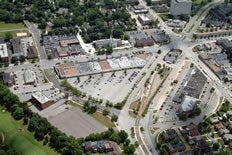Section 1: Understanding the Van Aken District Redevelopment Project
What the Site Looked Like Before Redevelopment
So, we’ve already identified problems with the old Warrensville/Van Aken site, but let’s go into more detail.
Before the Van Aken District was built, the area around Warrensville Center Road, Chagrin Boulevard, and Van Aken Boulevard looked very different. It was a confusing six-legged intersection surrounded by aging strip shopping centers, scattered buildings, and large surface parking lots.

Source: https://thevanakendistrict.com/about-us/
The area lacked a clear layout or focal point, which made it difficult to navigate and uninviting for pedestrians. Although a busy RTA rapid transit station sat nearby, there was no cohesive sense of place and very little reason for people to stay after catching a train or running a quick errand.
One of the city’s biggest concerns was safety. The six-legged intersection was one of the region’s most complex and dangerous. It had unusually long crossing distances for pedestrians, unclear sightlines for drivers, and traffic flowing in multiple directions at once. In fact, Shaker Heights recorded 91 crashes at or near the intersection in a single year, according to city data from the early 2000s. Several of these involved pedestrian injuries, which raised alarm among city officials. People walking to the transit stop or local businesses had to navigate a maze of crosswalks with little protection. The area felt more like a pass-through zone for cars than a walkable part of the city.
Beyond safety, the site suffered from economic and design challenges. Many storefronts were outdated or underused, with some commercial spaces sitting vacant for long periods. The buildings were set back from the street with parking lots in front, which discouraged walking and gave the area a disconnected feel. Even though Shaker Heights had a long tradition of thoughtful neighborhood design, this part of the city did not live up to that standard.

